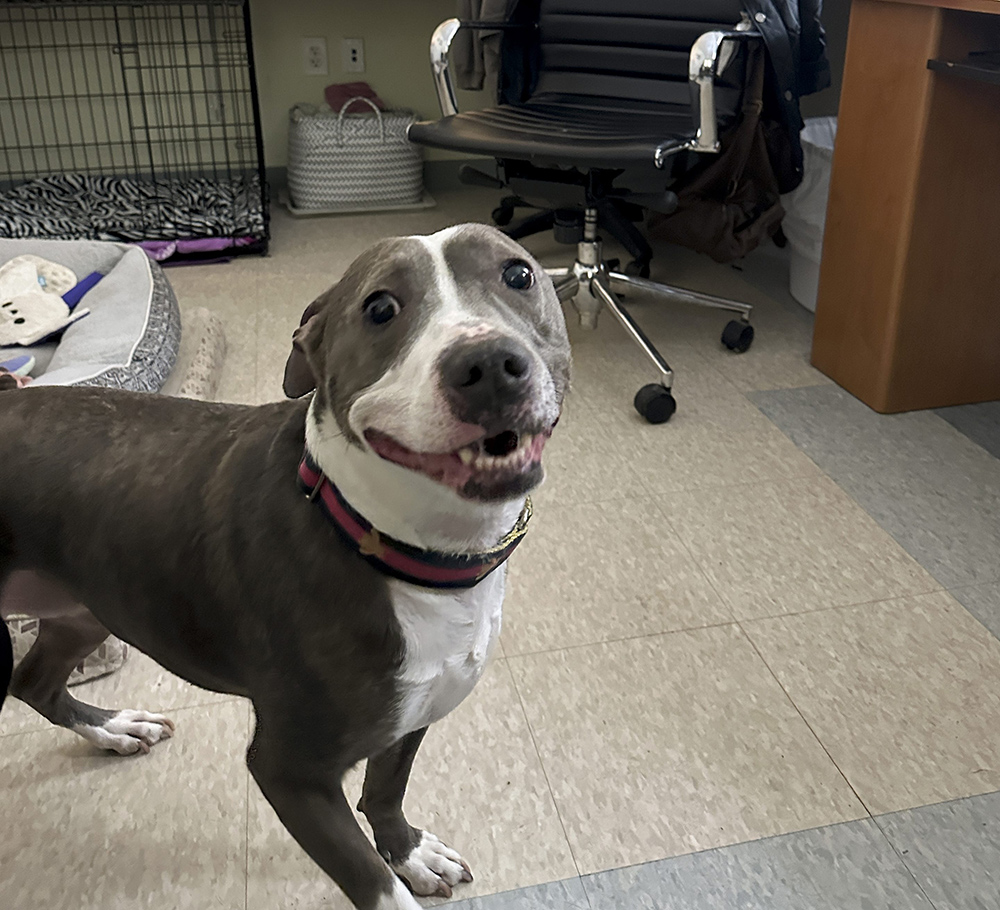
凯恩是一只活泼的大型狗,正在寻找收养家庭。但最近,它大部分时间都待在这间办公室里。
随着生活成本不断上涨,美国各地的动物收容所都狗满为患,所以这只灰白相间的7岁大狗一直待在Mohawk Hudson Humane Society的工作人员办公室里,等待领养。
纽约州奥尔巴尼附近的这家收容所已经“爆满”,首席执行官阿什利·杰弗里·布克说。这意味着凯恩(连同它的狗笼、狗床和咀嚼玩具)不得不与一名工作人员共用空间,办公室里还有一张办公桌和一个文件柜。
“它是我们所谓的‘办公室寄养动物’之一。”布克在最近参观凯恩的办公室时说。“它们整天整夜都在这里,不会被送进狗舍,原因是我们没有狗舍供它们住。”
在新冠肺炎疫情趋缓后,进入收容所的动物数量在2021年开始攀升。领养速度未能跟上宠物涌入的步伐,尤其是像凯恩这样的大型犬,使得许多收容所面临着滚雪球般动物爆量的问题。据追踪全美收容所统计数据的数据库收容所动物统计(Shelter Animals Count)估计,2023年美国收容所的动物数量增加了近25万只。
收容所的经营者表示,他们正陷入危机状态,原因是他们试图减少狗舍隔离区。
这一问题有时归咎于主人遗弃在新冠封锁期间购买的“疫情幼犬”。但倡导者和经营者表示,证据实际上指向经济因素,如宠物护理成本上升和住房安全问题。
美国动物福利组织必胜宠物基金会(Bissell Pet Foundation)的金·阿尔博姆(Kim Alboum)说:“如今的经济状况对很多家庭来说,确实是一大挑战。再加上住房危机,人们失去了自己的家,不得不缩小住家规模或与他人合住。这对于养大型犬的人来说,无疑是一场灾难。”
倡导者说,空间有限的收容所爆满,这与其说是猫造成的问题,不如说是狗造成的问题。例如,Mohawk Hudson Humane Society有很多比特犬、獒犬和卡斯罗犬。
有些人再也负担不起照顾宠物的费用,尤其是在兽医服务费用不断上涨的情况下。倡导者表示,兽医短缺造成宠物获得护理的机会减少,从而加剧了这一问题。
纽约市北部的阿尔斯特县爱护动物协会(SPCA)执行主任吉娜·卡博纳里(Gina Carbonari)说,她注意到近几个月来,越来越多的人来到他们的宠物食品银行索要狗粮。
动荡的房地产市场使问题进一步恶化。布克说,当租客驱逐事件增加时,流浪动物的数量也随之增加。当租客搬入新的、更经济实惠的住房时,他们经常会遇到宠物限制,体型较大的狗和比特犬更有可能被禁养。
卡博纳里说:“所以你现在必须做出选择:‘好吧,我有住房吗?还是我要带着狗流浪?’''
在俄亥俄州,因住房或经济困难而被移交给Cleveland Animal Protective League的动物数量今年猛增了56%,达到388只。这包括负担不起护理费用、与房东发生纠纷、正在搬家或无家可归的人等各种情况。好心人送来的流浪猫和小猫数量也大幅增加。
倡导者说,他们看到原本不必对动物实施安乐死的收容所,最近再次依赖这种做法来控制收容数量过剩。有些城市要求主人给宠物做绝育手术,但这样的政策通常难以执行。
在全美各地,收容所和倡导者正在努力减少收容量,鼓励更多人进行领养。
这包括扩大寄养计划,将动物送到临时家庭,而非收容所。其他计划则通过提供宠物食品银行和兽医服务(如绝育诊所)来减轻养狗或养猫人士的经济负担。
负责管理纽约市公立收容所的纽约市动物护理中心(Animal Care Centers of NYC)在今年夏天的数周内,仅限收容最紧急状况下的猫,从10月7日开始的六周内,也同样限制狗的收容。许多纽约市的收容所也将狗安置在办公室和走廊中,以避免执行安乐死。
去年,Mohawk Hudson Humane Society与市政当局签订的合约中减少收容流浪动物的数量,并决定不再继续收容遭主人弃养的宠物。
最佳朋友动物协会(Best Friends Animal Society)的首席执行官朱莉·卡斯尔(Julie Castle)认为,提高领养率尤为关键,她表示每年有数百万人购买新宠物,而成千上万的动物在收容所中丧生。
卡斯尔说:“我们知道人们会养宠物,所以让我们回归到真正的基本点,就是...宣传领养,因为归根结底,我们与饲养者和宠物店存在竞争关系。”
国家动物福利组织在犹他州经营着一个庇护所,它与企业、收容所和救援组织合作,在全国各地举办领养活动,免除或减免领养费用。
虽然一些收容所已经通过提高收容能力来应对收容压力,但倡导者认为,要想提出长期的解决方案,就必须正视收容所将动物安置在办公室的原因。
“人们会说,'哦,你们就不能多建狗舍吗?’”布克说。"新建的狗舍会在两秒钟内爆满。”(财富中文网)
译者:中慧言-王芳
凯恩是一只活泼的大型狗,正在寻找收养家庭。但最近,它大部分时间都待在这间办公室里。
随着生活成本不断上涨,美国各地的动物收容所都狗满为患,所以这只灰白相间的7岁大狗一直待在Mohawk Hudson Humane Society的工作人员办公室里,等待领养。
纽约州奥尔巴尼附近的这家收容所已经“爆满”,首席执行官阿什利·杰弗里·布克说。这意味着凯恩(连同它的狗笼、狗床和咀嚼玩具)不得不与一名工作人员共用空间,办公室里还有一张办公桌和一个文件柜。
“它是我们所谓的‘办公室寄养动物’之一。”布克在最近参观凯恩的办公室时说。“它们整天整夜都在这里,不会被送进狗舍,原因是我们没有狗舍供它们住。”
在新冠肺炎疫情趋缓后,进入收容所的动物数量在2021年开始攀升。领养速度未能跟上宠物涌入的步伐,尤其是像凯恩这样的大型犬,使得许多收容所面临着滚雪球般动物爆量的问题。据追踪全美收容所统计数据的数据库收容所动物统计(Shelter Animals Count)估计,2023年美国收容所的动物数量增加了近25万只。
收容所的经营者表示,他们正陷入危机状态,原因是他们试图减少狗舍隔离区。
这一问题有时归咎于主人遗弃在新冠封锁期间购买的“疫情幼犬”。但倡导者和经营者表示,证据实际上指向经济因素,如宠物护理成本上升和住房安全问题。
美国动物福利组织必胜宠物基金会(Bissell Pet Foundation)的金·阿尔博姆(Kim Alboum)说:“如今的经济状况对很多家庭来说,确实是一大挑战。再加上住房危机,人们失去了自己的家,不得不缩小住家规模或与他人合住。这对于养大型犬的人来说,无疑是一场灾难。”
倡导者说,空间有限的收容所爆满,这与其说是猫造成的问题,不如说是狗造成的问题。例如,Mohawk Hudson Humane Society有很多比特犬、獒犬和卡斯罗犬。
有些人再也负担不起照顾宠物的费用,尤其是在兽医服务费用不断上涨的情况下。倡导者表示,兽医短缺造成宠物获得护理的机会减少,从而加剧了这一问题。
纽约市北部的阿尔斯特县爱护动物协会(SPCA)执行主任吉娜·卡博纳里(Gina Carbonari)说,她注意到近几个月来,越来越多的人来到他们的宠物食品银行索要狗粮。
动荡的房地产市场使问题进一步恶化。布克说,当租客驱逐事件增加时,流浪动物的数量也随之增加。当租客搬入新的、更经济实惠的住房时,他们经常会遇到宠物限制,体型较大的狗和比特犬更有可能被禁养。
卡博纳里说:“所以你现在必须做出选择:‘好吧,我有住房吗?还是我要带着狗流浪?’''
在俄亥俄州,因住房或经济困难而被移交给Cleveland Animal Protective League的动物数量今年猛增了56%,达到388只。这包括负担不起护理费用、与房东发生纠纷、正在搬家或无家可归的人等各种情况。好心人送来的流浪猫和小猫数量也大幅增加。
倡导者说,他们看到原本不必对动物实施安乐死的收容所,最近再次依赖这种做法来控制收容数量过剩。有些城市要求主人给宠物做绝育手术,但这样的政策通常难以执行。
在全美各地,收容所和倡导者正在努力减少收容量,鼓励更多人进行领养。
这包括扩大寄养计划,将动物送到临时家庭,而非收容所。其他计划则通过提供宠物食品银行和兽医服务(如绝育诊所)来减轻养狗或养猫人士的经济负担。
负责管理纽约市公立收容所的纽约市动物护理中心(Animal Care Centers of NYC)在今年夏天的数周内,仅限收容最紧急状况下的猫,从10月7日开始的六周内,也同样限制狗的收容。许多纽约市的收容所也将狗安置在办公室和走廊中,以避免执行安乐死。
去年,Mohawk Hudson Humane Society与市政当局签订的合约中减少收容流浪动物的数量,并决定不再继续收容遭主人弃养的宠物。
最佳朋友动物协会(Best Friends Animal Society)的首席执行官朱莉·卡斯尔(Julie Castle)认为,提高领养率尤为关键,她表示每年有数百万人购买新宠物,而成千上万的动物在收容所中丧生。
卡斯尔说:“我们知道人们会养宠物,所以让我们回归到真正的基本点,就是...宣传领养,因为归根结底,我们与饲养者和宠物店存在竞争关系。”
国家动物福利组织在犹他州经营着一个庇护所,它与企业、收容所和救援组织合作,在全国各地举办领养活动,免除或减免领养费用。
虽然一些收容所已经通过提高收容能力来应对收容压力,但倡导者认为,要想提出长期的解决方案,就必须正视收容所将动物安置在办公室的原因。
“人们会说,'哦,你们就不能多建狗舍吗?’”布克说。"新建的狗舍会在两秒钟内爆满。”(财富中文网)
译者:中慧言-王芳
Kaine is a big, buoyant dog looking for a home. But lately, he’s spending a lot of time at the office.
Animal shelters around the U.S. are bursting at the seams amid the rising cost of living, so the gray and white 7-year-old has been staying in a worker’s office at the Mohawk Hudson Humane Society while awaiting adoption.
The shelter near Albany, New York, is “beyond full,” said CEO Ashley Jeffrey Bouck. That means Kaine — along with his crate, dog bed and chewy toys — has to share space with a staffer, a desk and file cabinets.
“He is one of our ‘office fosters’ as we’re calling it,” Bouck said as she visited Kaine’s office recently. “They are here all day and all night. They are not going into a kennel because we don’t have a kennel for them to go into.”
The number of animals entering shelters began to climb in 2021, after a pandemic-related dip. Adoptions haven’t kept pace with the influx of pets — especially larger dogs like Kaine — creating a snowballing population problem for many shelters. Shelter Animals Count, a national database of shelter statistics, estimates that the U.S. shelter population grew by nearly a quarter-million animals in 2023.
Shelter operators say they’re in crisis mode as they try to reduce the kennel crush.
The issue is sometimes blamed on owners abandoning “pandemic puppies” purchased during the COVID-19 lockdowns. But advocates and operators say the evidence actually points to economic factors such as higher pet care costs and housing insecurity.
“The economy right now is really challenging for a lot of families,” said Kim Alboum of the Bissell Pet Foundation, a national animal welfare organization. “And with the housing crisis, people are losing their homes and are having to downsize or move in with others. And this is a recipe for disaster for people that have larger dogs.”
Overcrowded shelters with limited space are more of a dog problem than a cat problem, advocates say. Mohawk Hudson, for instance, has a lot of pit bulls, mastiffs and cane corsos.
Some people can no longer afford to care for their pets, particularly when it comes to the rising cost of veterinarian services. Advocates say a shortage of veterinarians has exacerbated the problem by reducing access to care.
North of New York City, Ulster County SPCA executive director Gina Carbonari said she’s noticed more people coming in to their pet food pantry to ask for dog food in recent months.
The tumultuous housing market has added to the problem. Bouck said that when evictions increase, so too does the number of stray animals. When renters move into new, more affordable housing, they often encounter restrictions on pets, with larger dogs and pit bulls more likely to be barred.
“So you have to make a choice now,” Carbonari said, ”‘Well, do I have housing? Or am I going to be homeless with my dog?‘’’
In Ohio, the number of animals surrendered to the Cleveland Animal Protective League due to housing or financial challenges jumped by 56% this year to 388. That includes people who can’t afford the care, have a conflict with their landlord, are moving or have no home. The number of stray cats and kittens brought in by good Samaritans also has increased significantly.
Advocates say they’re seeing shelters that have not had to euthanize animals recently rely again on the practice to help control overpopulation. Some cities have required owners to spay or neuter their pets, but often such policies aren’t enforced.
Around the country, shelters and advocates are working to reduce intakes and encourage more adoptions.
That includes expanding foster programs that send animals to temporary homes instead of shelters. Other programs ease the financial burden of owning a dog or a cat, through pet food pantries and veterinary services like spay and neuter clinics.
Animal Care Centers of NYC, which runs New York City’s public shelters, limited cat intakes to only the most urgent cases for several weeks this summer and similarly limited dog intakes for six weeks beginning Oct. 7. Many New York City shelters also were keeping dogs in offices, as well as hallways, to avoid having to euthanize them.
Last year Mohawk Hudson reduced the number of its contracts with municipalities to take in strays and has decided not to keep taking in pets surrendered from owners.
Increasing adoptions is especially crucial, argued Best Friends Animal Society CEO Julie Castle, saying that millions of people buy new pets each year even as hundreds of thousands of animals die in shelters.
“We know people are going to get pets, so let’s go back to the basics of really … marketing adoptions, because at the end of the day, we are in a competitive space with breeders and pet stores,” Castle said.
The national animal welfare organization, which runs a sanctuary in Utah, partners with businesses and shelters and rescue groups to run adoption events around the country, where adoption fees are waived or reduced.
While some shelters have responded to the crush by adding more capacity, advocates believe a long-term solution has to confront the reasons why shelters are resorting to housing animals in their offices.
“People will say, ‘Oh, can’t you just build more kennels?'” Bouck said. “And we could fill those up in two seconds.”






